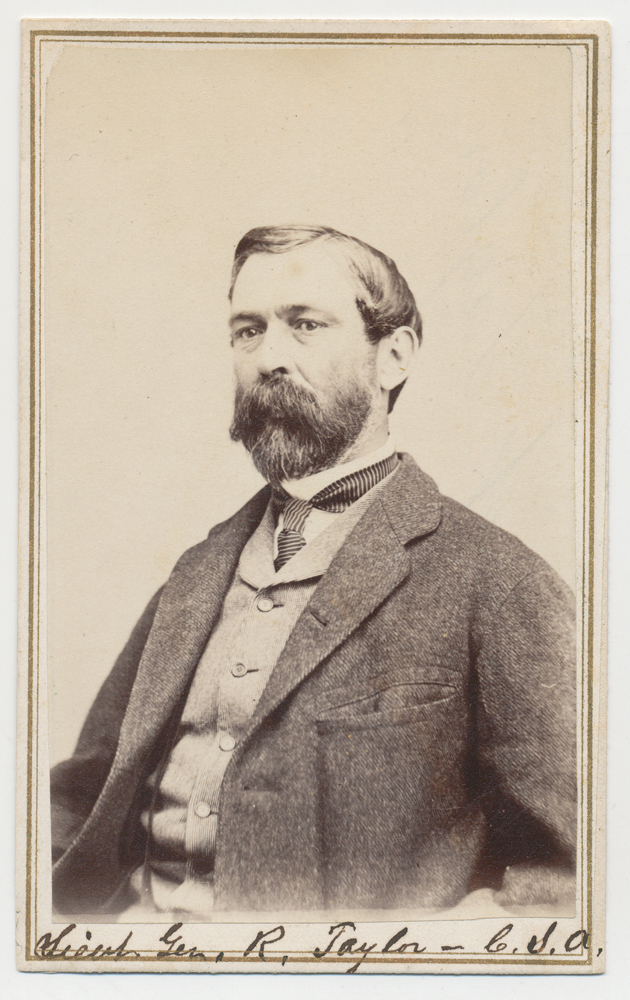site search
online catalog
POST-WAR VIEW OF ONE OF THE LAST CONFEDERATE GENERALS TO SURRENDER – RICHARD “DICK” TAYLOR; WITH NEW JERSEY BACKMARK

Hover to zoom


$325.00
Quantity Available: 1
Item Code: 1138-522
Shipping: Determined by Method & Location of buyer
To Order:
Call 717-334-0347,
Fax 717-334-5016, or E-mail
CDV is a waist-up view of Taylor in a dark civilian suit jacket, light vest, white shirt and striped tie. He is posed in a partial left profile.
Clarity and contrast are excellent. Paper and mount are very good. Bottom center of the mount has a period ink ID of “LIEUT. GEN. R. TAYLOR – C.S.A.”
Reverse has a photographer’s imprint for R. M. BOGGS … NEW BRUNSWICK, N.J.. There is a period pencil ID that reads “GEN. DICK TAYLOR.” Bottom has collector’s information in pencil.
From the collection of the late William A. Turner.
Richard Taylor was born on January 27, 1826 on his family’s plantation near Louisville, Kentucky. He was a brother-in-law of Jefferson Davis and also a son of President Zachary Taylor. He owned a large sugar plantation and was a Louisiana senator – first as a Whig, then a Know-Nothing, and then a Democrat. At first the Senator hoped to avoid secession. Eventually, however, Taylor felt that secession was inevitable and served as a delegate to the Louisiana secession convention.
In 1861, Taylor helped Braxton Bragg train soldiers at Pensacola, Florida. He was then elected Colonel of the 9th Louisiana Infantry which fought at Bull Run. In October 1861, he was appointed brigadier general of the Eighth Brigade (Louisiana soldiers) under Richard Ewell.
Taylor was skilled at leading his men at Front Royal, First Winchester and Port Republic (in the Shenandoah Valley). The Louisianans then fought in the Seven Days’ Battles. Unfortunately, Taylor suffered from serious rheumatoid arthritis. This left him incapacitated at times.
Promoted to major general, Taylor was sent to command the district of West Louisiana. Northern activities had left that region crippled; Taylor’s job was to organize forces to defend the state. Union goals at the time included establishing control of Louisiana in order to maintain a presence in Texas. Shreveport was their target. After an unsuccessful attempt to recapture New Orleans, Taylor embarrassed Union General Nathaniel Banks during the 1864 Red River Campaign. Banks suffered defeat at Mansfield (April 8) and Pleasant Hill (April 9) forcing Banks to abandon his plans to take Shreveport.
Because of disagreements with his superior officer, Gen. Edmund Kirby Smith, Taylor asked to be relieved of command. Instead, he was promoted to lieutenant general and sent to defend Mobile and Selma, Alabama. Before long Taylor was given command of John Bell Hood’s Army of Tennessee. On May 8, 1865, He was forced to surrender his army to General Edward Canby. This was the last major force to surrender east of the Mississippi. Taylor was paroled on May 13, 1865.
After the war, Taylor was vocal in his opposition to northern Reconstruction. He published a memoir entitled “Destruction and Reconstruction” in 1879, shortly before his death in New York City on April 12, 1879. He was buried in New Orleans Metairie Cemetery. [ad] [ph:L]
~~~~~~~~~~~~~~~~~~~~~~~~~~~~~~~~~~~
THIS ITEM, AS WITH ALL OTHER ITEMS AVAILABLE ON OUR WEB SITE,
MAY BE PURCHASED THROUGH OUR LAYAWAY PROGRAM.
CLICK HERE FOR OUR POLICIES AND TERMS.
THANK YOU!
Inquire About POST-WAR VIEW OF ONE OF THE LAST CONFEDERATE GENERALS TO SURRENDER – RICHARD “DICK” TAYLOR; WITH NEW JERSEY BACKMARK
Most Popular
Historical Firearms Stolen From The National Civil War Museum In Harrisburg, Pa »
Theft From Gravesite Of Gen. John Reynolds »
Selection Of Unframed Prints By Don Troiani »
Fine Condition Brass Infantry Bugle Insignia »
Large English Bowie Knife With Sheath 1870’S – 1880’S »
Imported (Clauberg) Us Model 1860 Light Cavalry Officer's Saber »
featured item
PROMOTED CAPTAIN ON THE SPOT ON THE BATTLEFIELD OF BENTONVILLE - THE EFFECTS OF DWIGHT DIVINE
This grouping includes a Kepi, a greatcoat, a sash and a pair of "full dress" epaulettes all belonging to 2nd Lieutenant to Major Dwight Divine, 143rd New York Infantry. For the history of the 143rd New York infantry please follow this link… (1268-309). Learn More »


